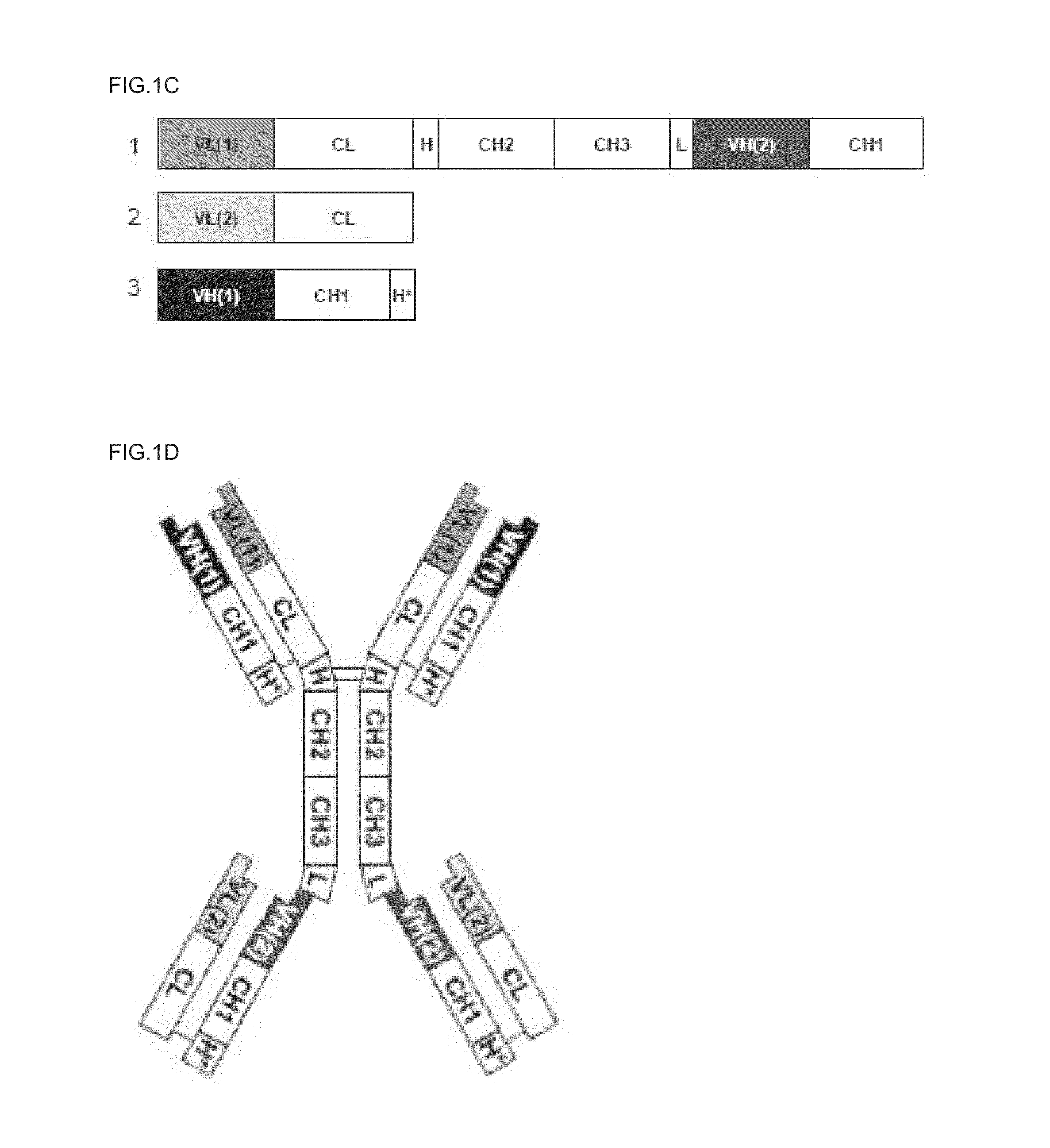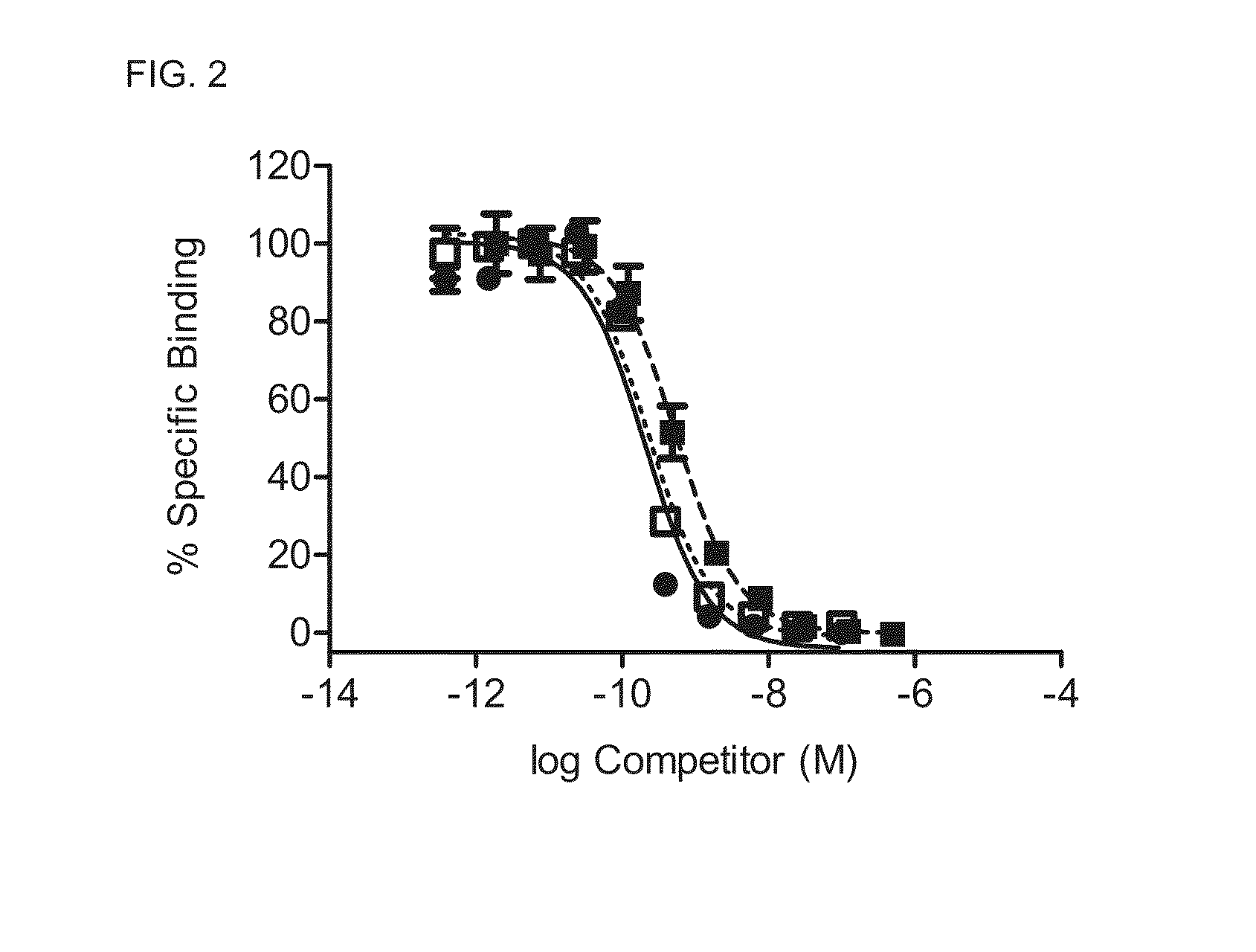Tetravalent bispecific antibodies
- Summary
- Abstract
- Description
- Claims
- Application Information
AI Technical Summary
Benefits of technology
Problems solved by technology
Method used
Image
Examples
example 1
Fc-Anti-EGFR Precursor Molecules
[0101]1A) Construction and Expression of Fc-Fab Precursors
[0102]In order to create full TetBiAb molecules, a number of Fc-Fab precursors were generated and tested to see if antigen binding of the Fab can still occur when the Fab is moved to the C-terminus of Fc. The generation of the Fc-anti-EGFR is based on the anti-EGFR C225 (cetuximab) monoclonal antibody (Kawamoto, PNAS 80:1337, 1983). The DNA and protein sequence of the Fab light chain for C225 are provided in SEQ ID NO:1 and SEQ ID NO:2, respectively. The DNA and protein sequence of the Fab heavy chain for C225 are provided in SEQ ID NO:3 and SEQ ID NO:4, respectively. Three different Fc-EGFR molecules were generated: (i) Fc-G4S-anti-EGFR(VHCH1), in which the C-terminus of the Fc region heavy chain is linked to the N-terminus of the anti-EGFR Fab heavy chain via a G4S linker (GGGGS, heavy chain is linked to the N-terminus of the anti-EGFR Fab light chain via a G4S linker; and (iii) Fc-(G4S)4-an...
example 2
Fo-Anti-CD20 Precursor Molecules
[0115]2A) Construction and Expression of Fc-Fab Precursors
[0116]The generation of Fc-anti-CD20 is based on the anti-CD20 2B8 (rituximab) monoclonal antibody (Reff et al, Blood 83:435, 1994). The DNA and protein sequence of the Fab light chain for 2B8 are provided in SEQ ID NO:21 and SEQ ID NO:22, respectively. The DNA and protein sequence of the Fab heavy chain for 2B8 are provided in SEQ ID NO:23 and SEQ ID NO:24, respectively. Four different Fc-CD20 molecules were generated: (i) Fc-G4S-anti-CD20(VHCH1), in which the C-terminus of the Fc region eavy chain is linked to the N-terminus of the anti-CD20 Fab heavy chain via a G4S linker (GGGGS, SEQ ID NO:6); (ii) Fc-(G4S)4-anti-CD20(VHCH1), which is the same molecule as (i) but with a quadruple repeat of the linker; (iii) Fc-G4S-anti-CD20(LC), in which the C-terminus of the Fc region heavy chain is linked to the N-terminus of the anti-CD20 Fab light chain via a G4S linker; and (iv) Fc-(G4S)4-anti-CD20(LC)...
example 3
Anti-EGFR / Anti-CD16 and Anti-CD16 / Anti-EGFR
[0126]3A) Construction and Expression of TetBiAbs
[0127]The generation of the TetBiAbs against EGFR and CD16 is based on the anti-EGFR C225 (cetuximab) monoclonal antibody (Kawamoto, PNAS 80:1337, 1983) and the anti-CD16 3G8 monoclonal antibody (Fleit et al, PNAS 79:3275, 1982). The DNA and protein sequence of the Fab light chain for C225 are provided in SEQ ID NO:1 and SEQ ID NO:2, respectively. The DNA and protein sequence of the Fab heavy chain for C225 are provided in SEQ ID NO:3 and SEQ ID NO:4, respectively. The DNA and protein sequence of the Fab light chain for 3G8 are provided in SEQ ID NO:37 and SEQ ID NO:38, respectively. The DNA and protein sequence of the Fab heavy chain for 3G8 are provided in SEQ ID NO:39 and SEQ ID NO:40, respectively. Two different TetBiAbs against EGFR and CD16 molecules were generated: (i) anti-EGFR / anti-CD16, in which the C-terminus of the anti-EGFR heavy chain polypeptide is linked to the N-terminus of t...
PUM
| Property | Measurement | Unit |
|---|---|---|
| Fraction | aaaaa | aaaaa |
Abstract
Description
Claims
Application Information
 Login to View More
Login to View More - R&D
- Intellectual Property
- Life Sciences
- Materials
- Tech Scout
- Unparalleled Data Quality
- Higher Quality Content
- 60% Fewer Hallucinations
Browse by: Latest US Patents, China's latest patents, Technical Efficacy Thesaurus, Application Domain, Technology Topic, Popular Technical Reports.
© 2025 PatSnap. All rights reserved.Legal|Privacy policy|Modern Slavery Act Transparency Statement|Sitemap|About US| Contact US: help@patsnap.com



